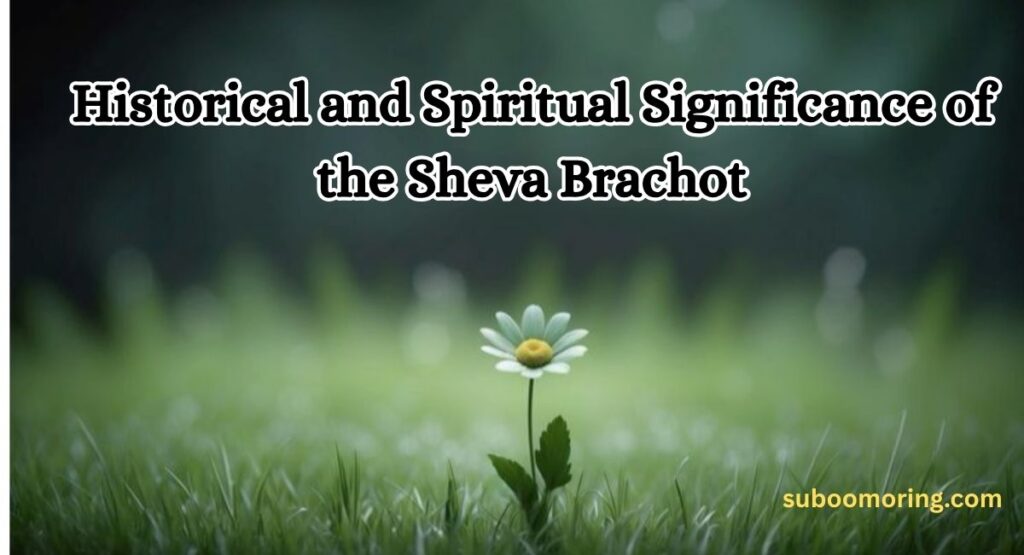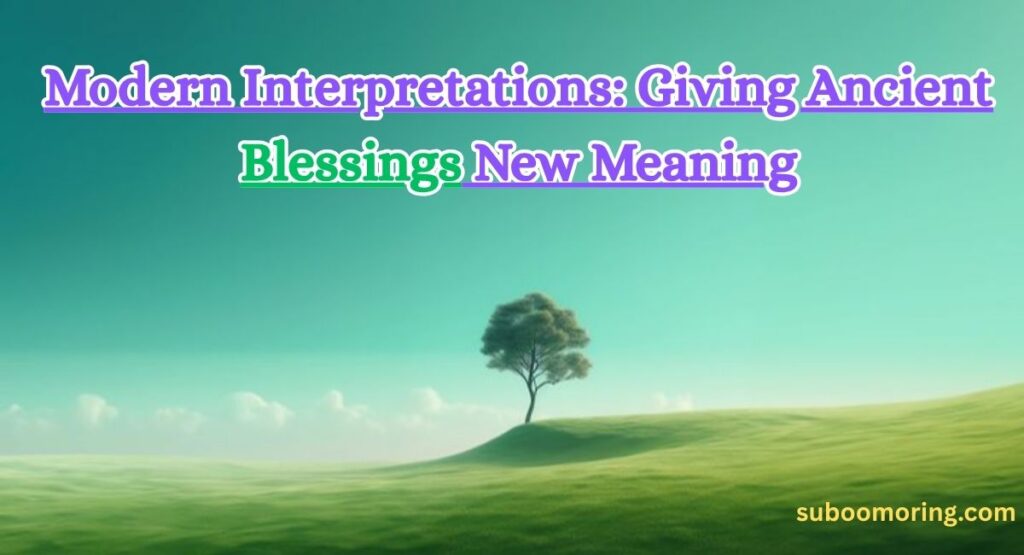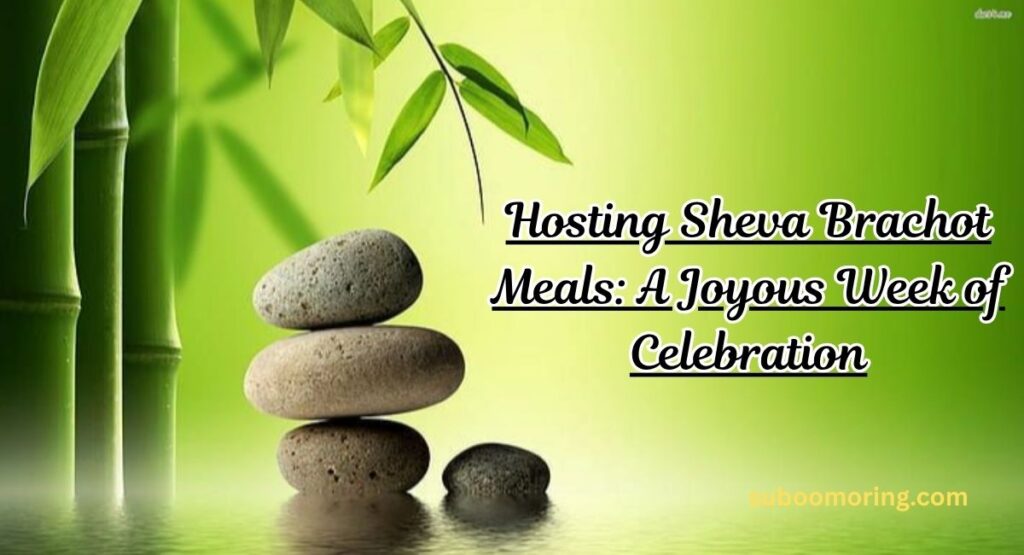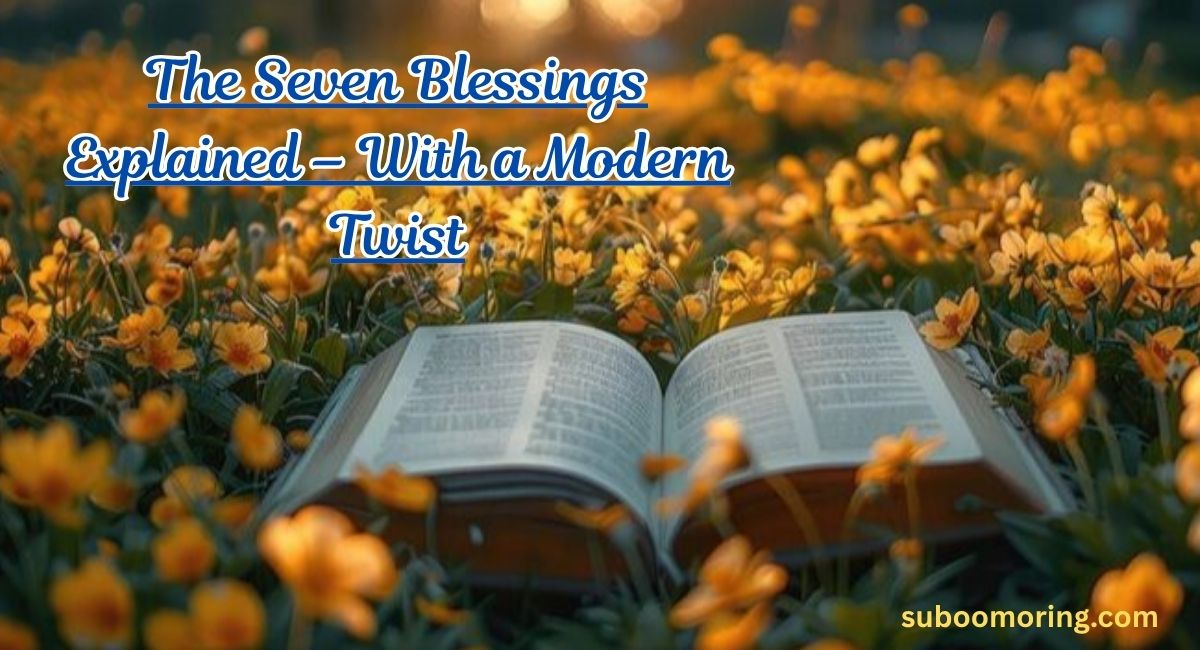The Seven Blessings Explained – With a Modern Twist invites you to explore one of the most beautiful and meaningful parts of a Jewish wedding ceremony. Known as the Sheva Brachot, these blessings have been central to Jewish wedding traditions for centuries. Recited under the chuppah, they celebrate love, creation, and community, weaving together a spiritual Jewish wedding experience rich with history. Yet today, many couples blend these traditional Jewish blessings with personal touches that reflect their unique values and modern relationships.
Whether in an Orthodox wedding or a contemporary ceremony, the Seven Blessings remain a powerful symbol of joy, unity, and commitment. This article will explain the origin and meaning of each blessing, explore their spiritual significance, and share how modern Jewish couples are giving the Sheva Brachot new life while honoring a timeless heritage.
What Are the Sheva Brachot (Seven Blessings) in a Jewish Wedding?
The Sheva Brachot, also called the Seven Blessings, are read during the Jewish marriage ceremony under the chuppah and throughout the first week of marriage. They mark the beginning of a sacred union and are often repeated at festive meals after the wedding.
These blessings have their roots in ancient Jewish texts. Over time, they’ve become a central part of Orthodox Jewish wedding customs and even in Reform and Conservative Judaism. Their meaning goes deeper than tradition—they highlight joy, creation, community, and love.
The Meaning Behind Each of the Seven Blessings
Each of the Seven Blessings adds something special to the ceremony. Let’s break them down:
1. Borei Pri Hagafen – The Blessing Over Wine
This blessing gives thanks for wine. In a Jewish wedding, wine symbolizes joy and holiness. Drinking from the same cup begins a new chapter of shared life.
2. Shehakol Bara Likhvodo – All for God’s Glory
This line reminds us that all creation brings divine presence and glory. It calls couples to build a faith-based relationship with spiritual love and mutual respect.
3. Yotzer Haadam – The Creation of Humanity
This blessing celebrates how humans were created. It speaks to two whole people joining as one, each with emotional depth, choosing to share a life journey.
4. Asher Yatzar – In the Divine Image
Here, we remember that all people are made in God’s image. It teaches that seeing your partner with kindness and dignity brings strength to the holy bond of marriage.
5. Sos Tasis – Rejoicing in Jerusalem
This blessing celebrates the joy and longing tied to Jerusalem. For couples, it means finding peace and home in each other after trials.
6. Sameach Tesamach – The Joy of Friendship
True love begins with friendship. This blessing asks that the couple be loving companions, celebrating their soulful love every day.
7. Asher Bara Sasson V’Simcha – A Celebration of Love and Unity
The final blessing is a joyful chorus. It mentions celebration, laughter, and togetherness. It wishes for a future of blessings of joy, laughter, and love.
Historical and Spiritual Significance of the Sheva Brachot

The Sheva Brachot, or Seven Blessings, hold a deep historical and spiritual place in Jewish wedding traditions. Rooted in ancient texts and passed down through generations, these blessings symbolize more than just good wishes—they reflect core Jewish marriage customs that celebrate the sacred union between two people. Traditionally recited under the chuppah, the blessings connect the couple’s love to broader themes of creation, community, and divine joy. Each blessing echoes a unique aspect of the Jewish worldview, from the miracle of creation to the joy of companionship and the hope for lasting peace.
Historically, the seven blessings appeared in the Talmud, where rabbis emphasized the importance of marking marriage as both a physical and spiritual bond. The blessings honor the sacredness of marriage, framing it as a holy commitment grounded in shared values and divine presence. This spiritual depth reinforces the idea that marriage is not only a social contract but a faith-based relationship that carries emotional and religious significance. The traditional Jewish blessings praise God for creating humanity, bringing joy, and establishing the family as the foundation of Jewish life.
In addition to their historical roots, the Sheva Brachot carry immense spiritual weight. They emphasize partnership with purpose and a spiritual love connection that supports the couple through life’s challenges. Each blessing highlights an essential quality—joy, unity, love, and peace—that shapes a successful marriage. The Jewish view on love and unity is woven into these prayers, reminding the couple and community of the eternal bond they are forming. Rabbinic commentary often explores how these blessings encourage mutual respect and emotional depth in marriage, making the wedding not just a celebration but a spiritual journey.
Moreover, the blessings link the couple to the Jewish community. The presence of friends and family during the recitation symbolizes the collective support and shared values that strengthen the union. This communal aspect ties into the broader Jewish wedding ceremony structure, where every ritual, including the breaking of the glass and Ketubah signing, reflects centuries of Jewish wedding heritage. Overall, the significance of Sheva Brachot lies in their ability to blend history, spirituality, and communal connection into a powerful expression of love and faith.
Modern Interpretations: Giving Ancient Blessings New Meaning

Today, many couples are embracing modern Jewish couple traditions by giving the Sheva Brachot fresh meaning. While rooted in traditional Jewish blessings, these sacred words now often reflect more inclusive values, blending Jewish wedding rituals with contemporary ideas. Couples may choose to personalize their blessings, creating custom wedding vows or using contemporary wedding rituals that honor both heritage and individuality.
This trend supports blending tradition and modern love, making the Jewish wedding ceremony feel more personal and relevant.
Modern versions of the Seven Blessings under the chuppah may include inclusive wedding blessings that welcome interfaith families or LGBTQ+ couples, emphasizing a spiritual yet modern wedding experience. Some couples opt for translations or new interpretations to deepen the emotional connection and highlight the spiritual journey of marriage. These adaptations show how the meaning of the Seven Blessings evolves, preserving their holy commitment while honoring today’s diverse expressions of love.
How to Incorporate the Seven Blessings in Your Wedding Ceremony
Including the Sheva Brachot in your Jewish wedding ceremony can create a meaningful and memorable experience for you and your guests. Traditionally, the seven wedding blessings are recited under the chuppah during the main ceremony. Often, a rabbi or cantor leads the prayers in Hebrew, followed by a translation so everyone can understand the sacred words. However, there’s plenty of room to personalize this moment. Some couples choose to have family members or close friends recite individual blessings. This not only involves loved ones but also adds a warm, intimate touch to the ritual.
You might decide to recite all seven blessings at once or spread them throughout your wedding events, such as during the ceremony and at the festive meals afterward. Modern Jewish couples often blend the traditional Jewish blessings with contemporary language or artistic elements. For example, some include musical renditions, poetry, or even write their own blessings inspired by the original Sheva Brachot.
This approach respects Jewish wedding heritage while making the ceremony feel personal and relevant. Whether you stick with the classic Hebrew prayers or choose a personalized wedding ceremony script, incorporating the Seven Blessings highlights the spiritual journey you are embarking on together. Thoughtful planning and creativity will help these ancient blessings resonate deeply, making your wedding both a celebration of tradition and a reflection of your unique love story.
Hosting Sheva Brachot Meals: A Joyous Week of Celebration
After the ceremony, many families host Sheva Brachot dinners for seven nights. These are joyous meals filled with blessings, laughter, and community. Each night includes a short ritual, including the Seven Blessings, sung or recited.

To plan these events, consider themes that reflect the couple’s life. You can rotate homes, invite different guests each night, and create fun menus. Jewish wedding meal traditions like challah, wine, and traditional dishes make each night a celebration.
Here’s a simple planning guide:
| Day | Host | Theme | Blessing Leader |
| 1 | Bride’s family | Homecoming | Rabbi |
| 2 | Groom’s friends | Travel & Adventure | Bride’s friend |
| 3 | Couple’s home | Music & Joy | Groom’s cousin |
| 4 | Aunt/Uncle | Roots & Heritage | Family elder |
| 5 | Best Friends | Friendship | Maid of Honor |
| 6 | Siblings | Future & Growth | Sibling pair |
| 7 | Both families | Gratitude | Parents |
Frequently Asked Questions About the Sheva Brachot
What is the purpose of the seven blessings?
The Seven Blessings celebrate the sacred union of marriage and ask for joy, love, and peace. They honor creation, community, and the couple’s future together. These blessings connect the wedding to Jewish tradition and spirituality.
What is the main plot of seven blessings?
The Seven Blessings are a series of prayers recited during the Jewish wedding ceremony. They praise God for creation, happiness, and the bond between the couple. The blessings express hope for a joyful, strong marriage.
Why does bride circle groom 7 times?
The bride circles the groom seven times to symbolize the creation of a new home and spiritual protection. The number seven reflects completeness in Jewish tradition. This ritual marks the start of their life together.
What are the seven types of blessings?
The seven blessings include praise for wine, creation of humanity, joy, and love. Each blessing focuses on a different aspect of life and marriage. Together, they form a holistic celebration of unity and faith.
What is the theme of the story “Blessings”?
The theme centers on gratitude, faith, and the power of connection. It highlights how blessings bring hope and meaning to life’s milestones. Ultimately, it’s about celebrating love and community.
The Sheva Brachot and the Future of Jewish Weddings
The Seven Blessings under the chuppah continue to evolve. For couples today, they represent more than a Jewish wedding tradition. They’re a chance to reflect, connect, and build a life of love, faith, and shared purpose.
From Ketubah signing to the blessing over wine in a Jewish wedding, each moment carries deep meaning. Yet with creativity and care, couples can create something both timeless and personal. This is the heart of the modern Jewish couple traditions—staying rooted in values while embracing change.
As you plan your big day, remember: the Sheva Brachot aren’t just ancient words. They are a mirror of who you are, what you believe, and the journey ahead.
Certainly! Here’s a 250-word conclusion for your article, keeping it conversational, informative, and SEO-friendly:
Conclusion: Embracing the Sheva Brachot in Today’s Jewish Weddings
The Sheva Brachot, or Seven Blessings, remain one of the most meaningful parts of any Jewish wedding ceremony. These traditional Jewish blessings carry centuries of history, spirituality, and emotion. But what makes them truly special today is how couples personalize and interpret them. Whether recited under the chuppah, at festive meals, or woven into a modern Jewish couple’s traditions, the Sheva Brachot celebrate not only the sacred union but also the unique story each couple shares.
Understanding the meaning behind the Seven Blessings helps deepen the significance of the ceremony. Each blessing highlights important themes like creation, joy, friendship, and unity—values that resonate across generations and cultures. From the blessing over wine in a Jewish wedding to the joyful cries of Mazel Tov, these moments connect the past with the present in a way that feels both timeless and fresh.
For couples planning their wedding, embracing the spiritual journey of the Sheva Brachot means blending respect for Jewish wedding heritage with a desire for a personalized wedding ceremony. Whether you choose to honor Orthodox wedding customs or explore inclusive wedding blessings for interfaith or LGBTQ+ couples, the blessings can adapt to reflect your values and relationship.
Ultimately, the Seven Blessings invite us all to celebrate love as a partnership with purpose, built on mutual respect, emotional connection, and a shared future. They remind us that marriage is not just a ceremony—it’s a sacred commitment filled with hope, joy, and the promise of a life together. So, as you prepare for your special day, let the Sheva Brachot inspire you to create a wedding that honors tradition while embracing the beauty of your modern love story.
Welcome! I’m a passionate digital creator with over 5 years of experience in delivering top-notch online services. I specialize in:
Social Media Services: Boost your presence on platforms like YouTube, TikTok, Instagram, and Facebook with tailored strategies.
Content Writing: Need high-quality articles or blog posts? I provide original, engaging, and SEO-friendly content.
Graphic Design: I design custom logos that stand out and reflect your brand identity.
Document Conversion: Fast and accurate conversion of documents into formats like JPG, PNG, PDF, and more.
Ads Management: I run and manage effective online advertising campaigns that drive real results.
I’m dedicated to helping individuals and businesses grow online through creative and reliable digital solutions. Let’s work together and bring your vision to life!


3 thoughts on “The Seven Blessings Explained – With a Modern Twist”